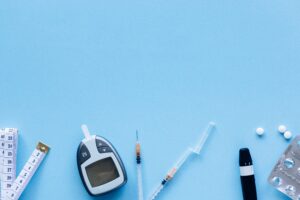Introduction
Diabetes is a chronic medical condition characterized by elevated levels of blood sugar (glucose). There are two main types of diabetes: Type 1 diabetes and Type 2 diabetes. While they share some common symptoms, there are also differences between them. It’s important to note that the symptoms can vary from person to person, and some individuals may not experience any symptoms at all. Here are the typical symptoms of each type:
Type 1 Diabetes Symptoms:

- Excessive Thirst (Polydipsia): Excessive thirst, known as polydipsia, is a hallmark symptom of Type 1 diabetes. People with this condition often experience an unquenchable thirst that drives them to drink unusually large amounts of water. Polydipsia occurs as a direct response to elevated blood sugar levels, which can result from a lack of insulin production in the body, a characteristic of Type 1 diabetes. In this form of diabetes, the absence of insulin prevents glucose from entering cells to provide energy, causing glucose to accumulate in the bloodstream. As a result, the body attempts to eliminate excess sugar through frequent urination, leading to dehydration and triggering an intense thirst sensation. Recognizing polydipsia as a warning sign is crucial, as it often serves as an early indicator prompting individuals to seek medical evaluation and initiate essential diabetes management and insulin therapy.
- Frequent Urination (Polyuria): Frequent urination, medically known as polyuria, is a hallmark symptom of Type 1 diabetes. This occurs because the body’s immune system mistakenly attacks and destroys the insulin-producing cells in the pancreas, leaving the body unable to effectively regulate blood sugar levels. When blood sugar levels become excessively high, as is often the case in Type 1 diabetes, the kidneys work to remove the excess glucose from the bloodstream. This process results in the production of a larger volume of urine, leading to frequent trips to the restroom. This symptom is not only inconvenient but also can contribute to dehydration if not managed properly. Recognizing polyuria as a potential sign of Type 1 diabetes is crucial for early diagnosis and prompt intervention to prevent further complications associated with this chronic condition.
- Extreme Hunger (Polyphagia): Extreme hunger, known as polyphagia, is a common and noteworthy symptom of Type 1 diabetes. In individuals with Type 1 diabetes, the body’s immune system mistakenly attacks and destroys the insulin-producing cells in the pancreas. Without sufficient insulin, glucose cannot enter cells to provide them with energy, even though there may be an excess of glucose circulating in the bloodstream. This cellular starvation triggers a profound sensation of hunger, compelling individuals to eat more frequently and in larger quantities. Despite the increased caloric intake, weight loss often occurs as the body resorts to breaking down stored fats and proteins for energy, as glucose remains inaccessible. Polyphagia, therefore, serves as a crucial warning sign of uncontrolled blood sugar levels in Type 1 diabetes, emphasizing the need for prompt diagnosis and appropriate insulin therapy to restore metabolic balance and alleviate this relentless hunger.
- Unexplained Weight Loss: Unexplained weight loss is a significant and concerning symptom often associated with Type 1 diabetes. In individuals with this autoimmune condition, the body’s immune system mistakenly attacks and destroys the insulin-producing cells in the pancreas. As a result, the body cannot effectively utilize glucose for energy, leading to the breakdown of fat and muscle tissues as an alternative source of fuel. This metabolic imbalance causes a noticeable and unintended reduction in body weight, even if the person is consuming more calories due to increased hunger. Unexplained weight loss is often one of the early signs of Type 1 diabetes and underscores the urgency of seeking medical attention for diagnosis and management. Timely intervention, including insulin therapy and dietary adjustments, is essential to stabilize blood sugar levels, prevent further weight loss, and promote overall well-being in individuals with Type 1 diabetes.

- Fatigue: Fatigue is a common and often debilitating symptom experienced by individuals with Type 1 diabetes. It occurs due to the body’s inability to properly utilize glucose for energy, as insulin production is either severely reduced or absent in this form of diabetes. Without insulin, glucose cannot enter cells, leading to a shortage of fuel for the body’s tissues and muscles. Consequently, individuals with Type 1 diabetes may feel persistently tired and lacking in energy, even if they have had enough sleep. Managing blood sugar levels with insulin therapy, regular monitoring, and a well-balanced diet is crucial in alleviating fatigue in Type 1 diabetes. Proper management not only helps prevent high or low blood sugar episodes but also contributes to improved energy levels and an overall better quality of life for those living with this condition.
- Blurry Vision: Blurry vision in Type 1 diabetes is a common symptom that arises from elevated blood sugar levels affecting the eye’s ability to focus properly. High glucose levels can lead to changes in the fluid balance within the lenses of the eye, causing them to swell and distort their shape. This, in turn, can result in blurry or fluctuating vision. While this symptom is often temporary and can improve with proper diabetes management, it should never be ignored. Untreated high blood sugar levels can lead to more severe eye complications, including diabetic retinopathy, which can potentially cause vision loss or blindness. Therefore, individuals with Type 1 diabetes who experience blurry vision should promptly seek medical attention and work closely with healthcare professionals to control their blood sugar levels and protect their vision. Regular eye exams are also essential in monitoring and managing diabetic eye health.
- Irritability and Mood Changes: Irritability and mood changes are common symptoms in individuals with Type 1 diabetes. These mood fluctuations can often be attributed to the physiological impact of fluctuating blood sugar levels. When blood glucose levels are too high (hyperglycemia) or too low (hypoglycemia), it can affect brain function and neurotransmitter activity, leading to irritability, mood swings, and sometimes even more severe emotional disturbances. Managing blood sugar levels through insulin therapy, proper nutrition, and regular monitoring is crucial in stabilizing mood and reducing these emotional symptoms. Additionally, diabetes management education and support can help individuals with Type 1 diabetes better understand how their condition impacts their emotions and develop strategies to cope with these mood changes effectively, improving their overall quality of life.
- Yeast Infections: Yeast infections, particularly genital yeast infections, are a relatively common issue for individuals with Type 1 diabetes. This heightened susceptibility is primarily attributed to elevated blood sugar levels, a hallmark of uncontrolled diabetes. High glucose levels create an environment conducive to yeast overgrowth, especially Candida, a type of yeast. When blood sugar is not well managed, it provides an abundant energy source for yeast, leading to their rapid proliferation. Common symptoms of yeast infections in individuals with Type 1 diabetes include itching, burning, and discomfort in the genital area for both men and women. Proper diabetes management, which involves maintaining blood sugar levels within a target range through medication, dietary choices, and lifestyle adjustments, is essential in preventing and alleviating these recurring infections. Effective blood sugar control helps restore the body’s natural defenses and reduce the risk of yeast infections, improving overall quality of life for those with Type 1 diabetes. Regular check-ups with healthcare providers are crucial to monitor and manage blood sugar levels, ensuring a healthier and more comfortable experience for individuals living with this chronic condition.
- Ketoacidosis (in severe cases): In severe cases of Type 1 diabetes, a potentially life-threatening condition known as diabetic ketoacidosis (DKA) can develop. DKA arises when there is a critical shortage of insulin in the body, leading to a buildup of ketones, acidic byproducts of fat metabolism, in the bloodstream. This harmful accumulation of ketones causes the blood’s pH to drop, resulting in a highly acidic environment. DKA typically manifests with symptoms such as severe dehydration, excessive thirst, frequent urination, nausea, vomiting, abdominal pain, confusion, and even a fruity odor on the breath. Left untreated, DKA can lead to a cascade of dangerous complications, including organ failure and coma. Immediate medical intervention, including intravenous fluids and insulin therapy, is essential to correct the imbalance and stabilize the patient’s condition. Monitoring and managing blood sugar levels diligently can help prevent the onset of diabetic ketoacidosis in individuals with Type 1 diabetes.
Type 2 Diabetes Symptoms:

- Frequent Urination (Polyuria): Frequent urination, known as polyuria, is a common symptom of Type 2 diabetes. In this condition, the body’s cells become resistant to the effects of insulin, a hormone that regulates blood sugar levels, leading to elevated glucose in the bloodstream. Excess glucose in the blood prompts the kidneys to work harder to filter and remove it, resulting in increased urine production. This frequent need to urinate can disrupt daily life and sleep patterns. It is often accompanied by an unquenchable thirst, as the body tries to compensate for fluid loss. Recognizing polyuria as a symptom of Type 2 diabetes is vital, as early diagnosis and management are essential in preventing complications and improving overall health. Controlling blood sugar levels through medication, lifestyle changes, and dietary adjustments can help alleviate this symptom and improve the quality of life for individuals with Type 2 diabetes.
- Excessive Thirst (Polydipsia): Excessive thirst, known medically as polydipsia, is a common symptom in individuals with Type 2 diabetes. It occurs as a result of the body’s struggle to regulate blood sugar levels effectively. In Type 2 diabetes, the cells in the body become resistant to the effects of insulin, a hormone that helps glucose enter cells for energy. This insulin resistance causes blood sugar levels to rise, leading to a variety of symptoms, including polydipsia. As glucose accumulates in the bloodstream, the kidneys work overtime to filter it out, leading to increased urine production and dehydration. To counteract this, the body signals a strong sensation of thirst, driving individuals to drink more fluids. While drinking water is essential for staying hydrated, excessive thirst in Type 2 diabetes is a crucial warning sign that should prompt individuals to seek medical evaluation and potentially make lifestyle changes or begin medication to manage their condition effectively.
- Extreme Hunger (Polyphagia): Extreme hunger, medically known as polyphagia, is a common symptom observed in individuals with Type 2 diabetes. It occurs as a result of the body’s inability to effectively utilize glucose for energy due to insulin resistance. When insulin resistance develops, the body’s cells don’t respond adequately to insulin, which is essential for glucose uptake. As a result, glucose remains in the bloodstream, leading to elevated blood sugar levels. To compensate for this energy deficit, the body signals a feeling of constant hunger, prompting individuals to eat more frequently and in larger quantities. This persistent hunger can contribute to overeating, weight gain, and difficulty in managing blood sugar levels. Managing polyphagia in Type 2 diabetes often involves lifestyle modifications, medication, and blood sugar monitoring to help regulate appetite and glucose levels effectively.
- Unexplained Weight Loss or Gain: Unexplained weight loss or gain can be a significant concern in Type 2 diabetes. While weight gain is often associated with this condition due to insulin resistance and increased hunger, some individuals may experience unexplained weight loss, which can be particularly worrisome. Weight loss in Type 2 diabetes is usually attributed to several factors, including the inability of the body’s cells to effectively use glucose for energy, resulting in muscle breakdown and fat loss. This can lead to a decrease in overall body mass. On the other hand, weight gain is often linked to insulin resistance, which can promote the storage of excess glucose as fat. Additionally, medications used to manage Type 2 diabetes, such as insulin or certain oral medications, can sometimes contribute to weight gain. Monitoring and managing weight in Type 2 diabetes are essential to achieving optimal blood sugar control and preventing further health complications. A healthcare provider can offer guidance on maintaining a healthy weight through diet, exercise, and medication management.
- Fatigue: Fatigue is a common and often debilitating symptom in individuals with Type 2 diabetes. This persistent and overwhelming tiredness can significantly affect their quality of life. The underlying mechanisms contributing to fatigue in Type 2 diabetes are multifaceted. One key factor is the body’s inability to efficiently utilize glucose for energy due to insulin resistance, resulting in lower energy levels. Fluctuations in blood sugar levels can also play a role, causing energy crashes when glucose levels drop too low or spike too high. Additionally, diabetes-related complications, such as sleep disturbances, neuropathy, and vascular issues, can contribute to fatigue. Lifestyle factors, including poor diet, sedentary habits, and stress, further exacerbate this symptom. Effective management of Type 2 diabetes, including blood sugar control, regular physical activity, a balanced diet, and stress reduction, can help mitigate fatigue and improve overall well-being for those living with the condition. Consulting with healthcare professionals is crucial to tailor a personalized treatment plan addressing the specific factors contributing to fatigue in each individual.

- Blurred Vision: Blurred vision is a common symptom experienced by individuals with Type 2 diabetes, and it often stems from fluctuations in blood sugar levels. Elevated blood sugar levels can lead to changes in the shape and function of the eye’s lens, causing it to swell, which, in turn, results in blurred or distorted vision. This condition is usually temporary and can improve with proper blood sugar control. However, if left unmanaged over the long term, it can contribute to more severe eye problems, including diabetic retinopathy, which can potentially lead to vision loss. Regular eye examinations are crucial for individuals with Type 2 diabetes to detect and address vision issues early, ensuring that appropriate treatments are initiated to protect their eye health and preserve their vision.
- Slow Wound Healing: Slow wound healing is a common and concerning complication associated with Type 2 diabetes. This condition, often referred to as diabetic ulcers, occurs due to various factors related to diabetes. Elevated blood sugar levels can damage blood vessels and impair the body’s natural ability to heal. Additionally, diabetes can lead to peripheral neuropathy, a condition that results in reduced sensation in the extremities, making individuals less aware of injuries or wounds. These factors combine to create an environment where even minor cuts, sores, or blisters can become slow-healing and, in some cases, non-healing wounds. This delayed wound healing can lead to serious complications, including infections and, in severe cases, the need for amputation. Managing blood sugar levels, proper wound care, and regular medical attention are crucial for individuals with Type 2 diabetes to prevent and address slow wound healing effectively.
- Frequent Infections:Frequent infections are a common concern for individuals with Type 2 diabetes. This heightened susceptibility to infections is primarily attributed to the elevated levels of glucose in the bloodstream, which can compromise the immune system’s ability to function effectively. High blood sugar provides an ideal environment for bacteria and fungi to thrive, making individuals with Type 2 diabetes more prone to infections, such as urinary tract infections, skin infections, and recurrent yeast infections. Moreover, diabetes-related complications, like neuropathy and poor circulation, can further increase the risk of infections, particularly in the extremities. Therefore, individuals with Type 2 diabetes must diligently manage their blood sugar levels, adhere to proper hygiene practices, and work closely with healthcare providers to prevent and promptly address any infections that may arise, thus ensuring better overall health and quality of life.
- Tingling or Numbness in Extremities: Tingling or numbness in extremities is a common and often unsettling symptom associated with Type 2 diabetes, a chronic metabolic disorder characterized by high blood sugar levels. This sensation typically occurs due to nerve damage, a condition known as diabetic neuropathy. Prolonged exposure to elevated glucose levels can harm the peripheral nerves, particularly in the hands and feet. As a result, individuals with Type 2 diabetes may experience a tingling, pins-and-needles sensation, or even numbness in these extremities. Diabetic neuropathy can be progressive and impact a person’s quality of life, making it essential for those with Type 2 diabetes to manage their blood sugar levels effectively through lifestyle modifications and medications as prescribed by healthcare professionals. Early detection and proper diabetes management can help mitigate the risk and severity of neuropathic symptoms, enhancing overall well-being and preventing complications.
- Gestational Diabetes (in pregnant women): Some women may develop Type 2 diabetes during pregnancy (gestational diabetes), which can lead to similar symptoms and complications.
It’s crucial to recognize these symptoms and seek medical attention for proper diagnosis and management. Early diagnosis and treatment can help individuals with diabetes lead healthier lives and reduce the risk of complications. If you or someone you know is experiencing these symptoms, consult a healthcare professional for a thorough evaluation and appropriate management.


